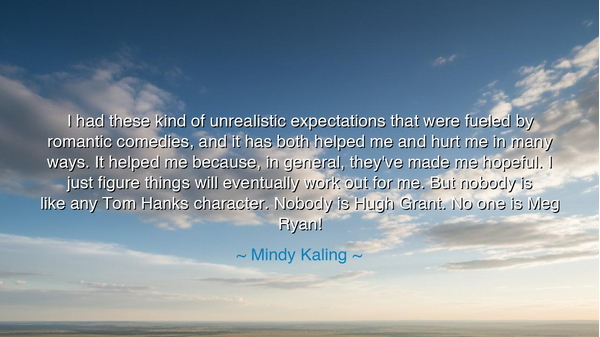
I had these kind of unrealistic expectations that were fueled by
I had these kind of unrealistic expectations that were fueled by romantic comedies, and it has both helped me and hurt me in many ways. It helped me because, in general, they've made me hopeful. I just figure things will eventually work out for me. But nobody is like any Tom Hanks character. Nobody is Hugh Grant. No one is Meg Ryan!






Hear the words of Mindy Kaling, who, with both humor and honesty, once declared: “I had these kind of unrealistic expectations that were fueled by romantic comedies, and it has both helped me and hurt me in many ways. It helped me because, in general, they’ve made me hopeful. I just figure things will eventually work out for me. But nobody is like any Tom Hanks character. Nobody is Hugh Grant. No one is Meg Ryan!” Within this confession lies the paradox of dreams: they can give us wings, yet also blind us to the ground beneath our feet.
The romantic comedy, with its laughter and charm, was never merely a form of entertainment. It was a myth for the modern age, a story whispered to us that love is inevitable, that destiny arranges meetings in bookstores, airports, and rainy city streets. It painted men as endlessly patient and witty, women as perfectly imperfect and always lovable, and endings as harmonies without discord. For Kaling, as for many, these stories became the script for expectation. They created a vision of love both luminous and deceptive—hopeful, yes, but also unrealistic.
And yet, she does not cast away these films with scorn. She honors them for their hopefulness, for their ability to light a candle in the heart. To believe, as Kaling says, that “things will eventually work out” is no small gift. Hope has carried men and women through wars, through exile, through despair. In this, the romantic comedy plays the role once held by myth or scripture: it tells us that love, though delayed, will come; that suffering, though real, will end in joy. This is why she calls it a help, even while naming it a burden.
But then comes her sharp truth: “Nobody is like any Tom Hanks character. Nobody is Hugh Grant. No one is Meg Ryan.” Here, she pierces the veil. The roles played by these beloved actors were crafted not for truth, but for longing. They showed us not people, but ideals—gentlemen who never falter, heroines who always find grace, relationships built in ninety minutes with neat resolutions. Real love is not so simple. It is harder, messier, filled with doubts, and often devoid of scripted charm. By naming these icons, Kaling reminds us that life is not lived on the movie screen.
History itself offers countless examples of this struggle between romance and reality. Consider the marriages of medieval royalty, often arranged for power rather than love. The troubadours sang songs of knights and maidens, of courtly passion and eternal devotion, yet behind castle walls the reality was duty, betrayal, and politics. The songs gave hope, but they were not the truth. So too with the romantic comedies of our age: they are the troubadour’s ballads of modern times—beautiful, inspiring, but often detached from the lives we must truly live.
The meaning of Kaling’s words is thus twofold. On one hand, she warns us not to confuse art with life, nor to expect perfection in those we love. To seek Tom Hanks or Meg Ryan in real relationships is to court disappointment. On the other hand, she defends the power of hope, even if born of illusion. For to live without hope is to walk in darkness, and if a story can make us believe in light, then even a false story holds value. The wisdom lies in balance: to keep hope without clinging to fantasy, to love truly without demanding perfection.
Therefore, children of tomorrow, learn this lesson: cherish the stories that make you hopeful, but do not demand that life obey them. Seek not a perfect hero, but a flawed companion who chooses you. Seek not a scripted ending, but a love that endures in its imperfection. Let your expectations be tempered by truth, yet keep the flame of hope alive. For romance is not the neatness of a film, but the messy, stubborn, beautiful work of two souls choosing each other again and again.
Thus, Kaling’s words, wrapped in laughter, are in truth a teaching: be grateful for the dream, but live in the real. Love the story, but write your own. And in the end, remember—no one is Tom Hanks, Hugh Grant, or Meg Ryan, but if you open your heart, you may find something even greater: someone real.






AAdministratorAdministrator
Welcome, honored guests. Please leave a comment, we will respond soon